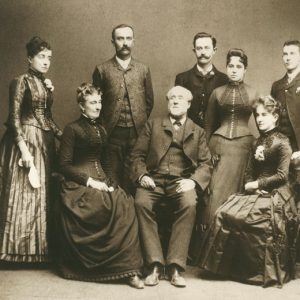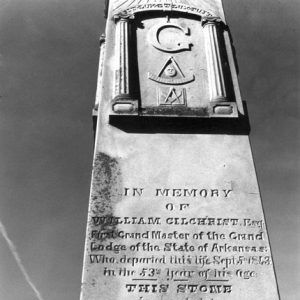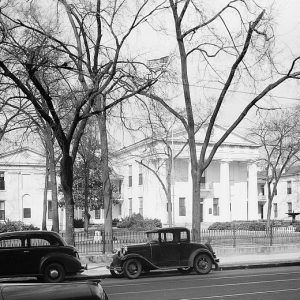calsfoundation@cals.org
Robert Brownlee (1813–1897)
Robert Brownlee was a Scottish stonemason who lived in Little Rock (Pulaski County) from 1837 to 1849. He helped build the first statehouse in Arkansas and several other historic landmarks in Pulaski County.
Robert Brownlee was born on April 24, 1813, in Bonkle, Cambusnethan Parish, a tiny community in the Scottish lowlands. He was ninth in a family of seven sons and four daughters born to Margaret and Alexander Brownlee. After a basic education at Murdestoun Estate School near Bonkle, he apprenticed to his older brother, William, a stonecutter.
Brownlee was twenty-three when he read about the December 1835 fire that almost destroyed New York City and the need for mechanics to help rebuild the city. That same day, he booked passage on the bark Tasso, arriving in New York on May 10, 1836, where he found work cutting stone for a building at 20th Street and 8th Avenue. Four months later, he was hired by the architect for the State House in Raleigh, North Carolina, to cut stone for the capitol building that Brownlee called “the finest I ever worked on.” As the building neared completion, he learned that skilled masons were needed in Little Rock to help finish what would come to be known as the Old State House, located at 300 West Markham. Brownlee and three friends—James McVicar, Samuel McMorrin, and John Cooper—also stonecutters who had worked with him in New York and North Carolina, left for Little Rock, arriving in December 1837. They organized as McVicar and Company, quarried stone, and set foundations for the east and west wings of the building, which had been designed by Kentucky architect Gideon Shryrock. The central section had been completed in 1836 in time for the inauguration of Arkansas’s first elected governor, James S. Conway. Brownlee and friends finished setting stone for the foundations of the two wings by 1840. Bricklayers then went to work on the walls and completed the building in 1842.
Brownlee professed to be a Whig and a supporter of William Henry Harrison and applied for citizenship in North Carolina, receiving his naturalization papers in Arkansas in 1839 so that he could vote in the 1840 election.
Work was difficult to find following the Panic of 1837, an economic depression that lasted through the early 1840s, but Brownlee learned to do many skilled labor jobs. He cut stone for window and doorjambs for the State Penitentiary in Little Rock in 1840, where James McVicar served as warden until 1849. He had previously cut stone for the Real Estate Bank in Little Rock, which opened its doors in 1838. Next, he learned to lay brick and, with McMorrin, built a detached brick kitchen at the rear of John McHenry’s Stagecoach House (also called the Ten Mile House). The McHenry house had been designed by Gideon Shryock about 1835 and was the oldest brick building in Pulaski County. The property, on present-day Interstate 30, about ten miles south of Little Rock, was situated upon the first traveled road in Arkansas, the Southwest Trail. Brownlee and McMorrin built the kitchen between 1840 and 1842, which is a smaller replica of Brownlee’s Little Rock house, with high chimneys at each end, staggered brick edging under the eves, and a central doorway. They lived on the farm with McHenry for a number of years, and during this time, Brownlee and McMorrin tried many ways to make a living. They tried farming and failed at that venture. Next, they purchased government land on which to mine for lead. That too, was a failure, and Brownlee gave up that business following a serious mine accident in 1848.
Brownlee and McMorrin also created the monument to William Gilchrist, Grandmaster Mason of the Grand Lodge of Arkansas, who died in 1843. The sixteen-foot gravestone sits on a nine-foot base and dominates the Masonic plot in Mount Holly Cemetery in Little Rock.
Two of Brownlee’s brothers, Thomas and James, immigrated to Little Rock in 1842, and Brownlee built a two-room brick house in the neoclassic style for James. The Brownlee House is preserved on its original site at the Historic Arkansas Museum in Little Rock at 3rd and Cumberland streets.
Brownlee and McVicar shared the adventures of the Little Rock Company as they trekked overland through Indian Territory, New Mexico, and Arizona during the California Gold Rush of 1849. Brownlee had met Annie Lamont in Little Rock before his California journey and arranged to marry her on his return. They married in New York on October 26, 1852, and left for California via the Isthmus of Panama. They lived in the town of Vallejo in northern California before moving permanently to their ranch, Brownlee Ranch (also known as Sunnyside Farm), in Napa Valley in 1857. Robert and Annie Brownlee had seven children: Robert A., Mary Jane, Margaret Russell, Grace Annie, George Lamont, William, and Frederick James.
Brownlee died on November 19, 1897, and is buried in Tulocay Cemetery in Napa.
For additional information:
Brownlee, Robert. An American Odyssey: The Autobiography of a 19th-Century Scotsman, Robert Brownlee, at the Request of His Children. Napa County, California, October 1892. Edited by Patricia A. Etter. Fayetteville: University of Arkansas Press, 1986.
DeSpain, Richard. More Than a Memory: Little Rock’s Historic Quapaw Quarter. Little Rock: Rose Publishing Company, 1981.
Ross, Margaret Smith. “The McHenry Family: Pulaski County Pioneers.” Pulaski County Historical Review 3 (March 1955): 3–9.
Patricia A. Etter
Labriola National American Indian Data Center
Arizona State University


 Robert Brownlee Family
Robert Brownlee Family  Freemason Monument
Freemason Monument  Old State House
Old State House 



Comments
No comments on this entry yet.